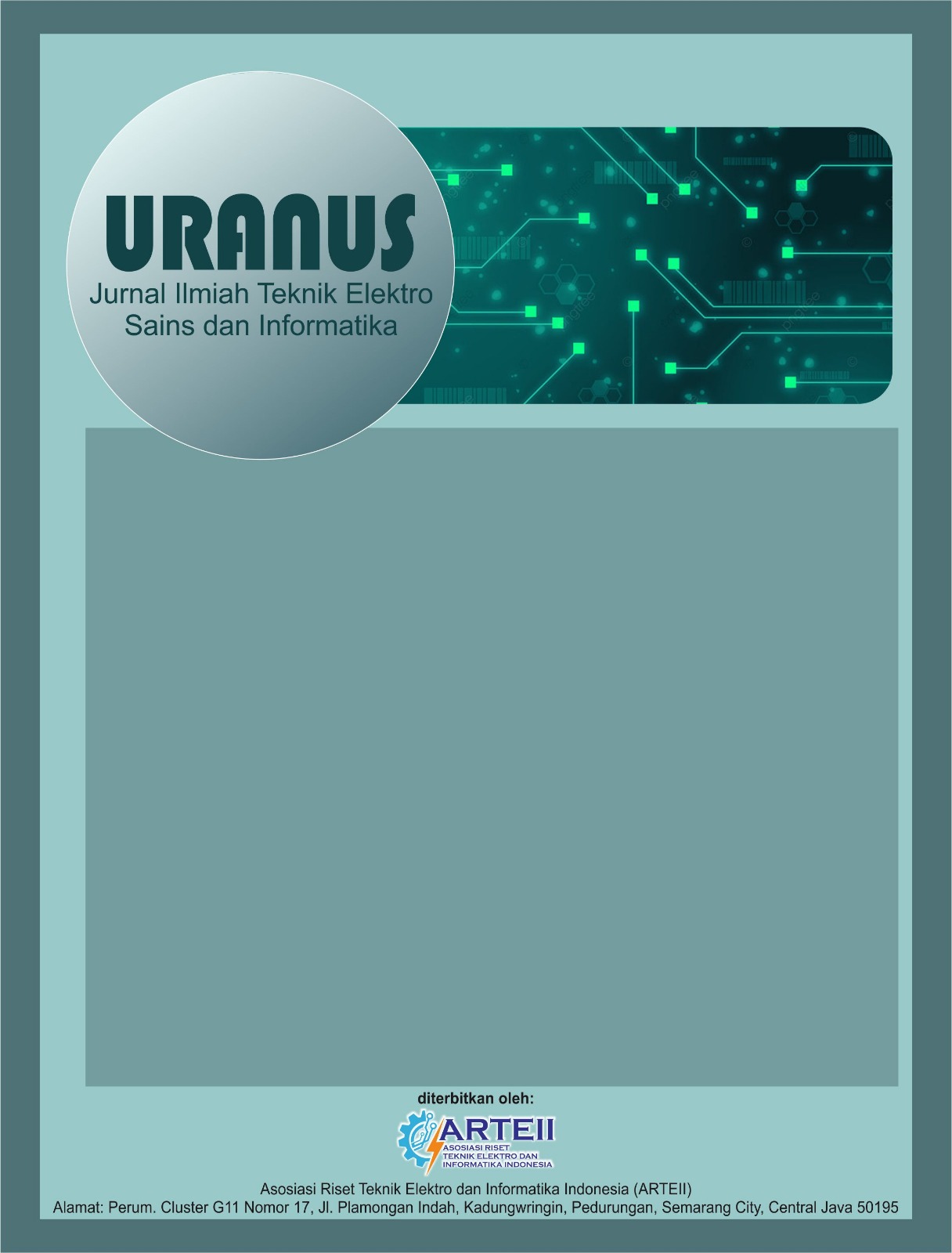Magnetoelectric Studies on Curcumin : Analysis of Voltage and Conductivity in Electrochemical Mediums Based Fuzzy Logic
DOI:
https://doi.org/10.61132/uranus.v3i1.704Keywords:
Curcumin Concentration, Copper Winding, Op Amp, Fuzzy LogicAbstract
In the curcumin compound there are aromatic compounds that have electronic spins on each side of the benzene. In previous research, the concentration of curcumin and H2O as coatings on copper coils could provide physical changes to the characteristics of copper coils, namely increasing the strength of the magnetic field and increasing the electric current in the coil. The fuzzification process can be described using membership variables with concentrations of curcumin and H2O as input, magnetic field strength and current as output. It is known that the greatest concentration of curcumin indicates increased magnetic field strength and electric current. Simulation of the aromatic spin on the curcumin compound as an Op Amp shows that the highest curcumin concentration value results in an increase in the output voltage (Vout).
References
J. Ali, J. Najeeb, M. Asim Ali, M. Farhan Aslam, and A. Raza, "Biosensors: Their Fundamentals, Designs, Types and Most Recent Impactful Applications: A Review," J. Biosens. Bioelectron., vol. 08, no. 01, pp. 1–9, 2017, doi: 10.4172/2155-6210.1000235. [2] B. A. Bartley, K. Kim, J. K. Medley, and H. M. Sauro, "Synthetic Biology: Engineering Living Systems from Biophysical Principles," Biophys. J., vol. 112, no. 6, pp. 1050–1058, 2017, doi: 10.1016/j.bpj.2017.02.013.
W. Batista-Silva, P. da Fonseca-Pereira, A. O. Martins, A. Zsögön, A. Nunes-Nesi, and W. L. Araújo, "Engineering Improved Photosynthesis in the Era of Synthetic Biology," Plant Commun., vol. 1, no. 2, 2020, doi: 10.1016/j.xplc.2020.100032.
L. T. Collins and D. T. Curiel, "Synthetic Biology Approaches for Engineering Next-Generation Adenoviral Gene Therapies," ACS Nano, vol. 15, no. 9, pp. 13970–13979, 2021, doi: 10.1021/acsnano.1c04556.
BioBuilder, "BioBuilding: Synthetic Biology for Students."
V. Grubelnik, B. Dugonik, D. Osebik, and M. Marhl, "Signal amplification in biological and electrical engineering systems. Universal role of cascades," Biophys. Chem., vol. 143, no. 3, pp. 132–138, 2009, doi: 10.1016/j.bpc.2009.04.009.
E. Matito, "Electronic Aromaticity Index for Large Rings," 2016, doi: 10.1039/C6CP00636A.
R. Mancini, "Op Amps for Everyone," 2017, doi: 10.1016/B978-0-12-811648-7.01001-3.
J. J. Y. Teo and R. Sarpeshkar, "The Merging of Biological and Electronic Circuits," iScience, vol. 23, no. 11, p. 101688, 2020, doi: 10.1016/j.isci.2020.101688.
H. Matsui, K. Hayasaka, Y. Takeda, R. Shiwaku, J. Kwon, and S. Tokito, "Printed 5-V organic operational amplifiers for various signal processing," Sci. Rep., vol. 8, no. 1, pp. 1–9, 2018, doi: 10.1038/s41598-018-27205-7.
S. A. W. G.E. Bacon, N. A. Curry, "Structure and Stability of Benzene," Libretexs, 1964. [Online]. Available: https://chem.libretexts.org/Bookshelves/Organic_Chemistry/Organic_Chemistry_(LibreTexts)/15%3A_Benzene_and_Aromaticity/15.02%3A_Structure_and_Stability_of_Benzene. [12] D. J. Raymond, "Magnetic Induction and Inductors."
S. Mühl and B. Beyer, "Bio-organic electronics—Overview and prospects for the future," Electron., vol. 3, no. 3, pp. 444–461, 2014, doi: 10.3390/electronics3030444. [14] M. Santhanalakshmi and P. T. Vanathi, "A 1.2V Improved operational amplifier for bio-medical applications," vol. 9, no. 4, 2012.
V. Šimić De Torres, "Instrumentation Amplifiers for the Measurement of Biosignals," 2020.
G. Patrick, M. Sridhar, and J. Kishore Babu, "Electrical resistivity and setting characteristics of some biomaterials," Mater. Today Proc., vol. 44, pp. 2797–2801, 2021, doi: 10.1016/j.matpr.2020.12.832.
E. Lab, "Multisim 14 Tutorial," pp. 1–7, 2009.
C. Liao, M. Zhang, M. Y. Yao, T. Hua, L. Li, and F. Yan, "Flexible Organic Electronics in Biology: Materials and Devices," Adv. Mater., vol. 27, no. 46, pp. 7493–7527, 2015, doi: 10.1002/adma.201402625.
D. Kraft, G. Bordogna, and G. Pasi, "Fuzzy Set Theory," Encycl. Comput. Sci. Technol., pp. 441–458, 2021, doi: 10.1201/9781315115894-44.
M. I. Dieste-Velasco, "Application of a fuzzy inference system for optimization of an amplifier design," Mathematics, vol. 9, no. 17, 2021, doi: 10.3390/math9172168.
W. Zainal Abidin, E. Siswanto, and W. Wijayanti, "The Effect of Coating Concentration of Curcumin: H2O on Copper Winding Characteristic," Eastern-European J. Enterp. Technol., vol. 3, no. 6, pp. 42–55, 2023, doi: 10.15587/1729-4061.2023.275727. [22] J. K. Roberge, Operational Amplifiers: Theory and Practice. 1975.
S. Jain, "Design and simulation of fuzzy membership functions for the fuzzification module of fuzzy system using operational amplifier," Int. J. Syst. Control Commun., vol. 6, no. 1, pp. 69–83, 2014, doi: 10.1504/IJSCC.2014.062805.
M. Rauhalahti, Quantum Chemical Studies of Ring Currents Of Aromatic Molecules, no. November, 2022.
B. M. Samuel, J. Ling, and J. Sanny, "14.3: Self-Inductance and Inductors."
Downloads
Published
How to Cite
Issue
Section
License
Copyright (c) 2025 Uranus : Jurnal Ilmiah Teknik Elektro, Sains dan Informatika

This work is licensed under a Creative Commons Attribution-ShareAlike 4.0 International License.





